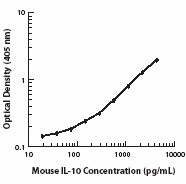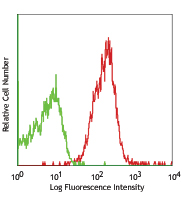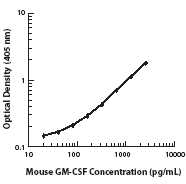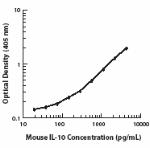- Clone
- JES5-2A5 (See other available formats)
- Regulatory Status
- RUO
- Other Names
- Interleukin-10, Cytokine synthesis inhibitory factor (CSIF), B cell derived T cell growth factor (B-TCGF), T cell growth inhibitory factor (TGIF)
- Isotype
- Rat IgG1, κ
- Ave. Rating
- Submit a Review
- Product Citations
- 2 publications
| Cat # | Size | Price | Quantity Check Availability | Save | ||
|---|---|---|---|---|---|---|
| 504912 | 100 mg | 2707€ | ||||
| 504910 | 25 mg | 1127€ | ||||
| 504911 | 50 mg | 1884€ | ||||
| 504907 | 100 µg | 88€ | ||||
| 504908 | 1 mg | 120€ | ||||
| 504909 | 5 mg | 432€ | ||||
IL-10 was originally described as Cytokine Synthesis Inhibitory Factor (CSIF) by virtue of its ability to inhibit cytokine production by Th1 clones. IL-10 shares over 80% sequence homology with the Epstein-Barr virus protein BCRFI. The biological activities of IL-10 include inhibition of macrophage-mediated cytokine synthesis, suppression of the delayed type hypersensitivity response, and stimulation of the Th2 cell response, which results in elevated antibody production. The JES5-2A5 antibody reacts with mouse interleukin-10 (IL-10). The JES5-2A5 antibody can neutralize the bioactivity of natural or recombinant IL-10.
Product DetailsProduct Details
- Verified Reactivity
- Mouse
- Antibody Type
- Monoclonal
- Host Species
- Rat
- Immunogen
- E. coli-expressed, recombinant mouse IL-10
- Formulation
- 0.2 µm filtered in phosphate-buffered solution, pH 7.2, containing no preservative.
- Endotoxin Level
- Less than 0.01 EU/µg of the protein (< 0.001 ng/µg of the protein) as determined by the LAL test.
- Preparation
- The Ultra-LEAF™ (Low Endotoxin, Azide-Free) antibody was purified by affinity chromatography.
- Concentration
- The antibody is bottled at the concentration indicated on the vial, typically between 2 mg/mL and 3 mg/mL. Older lots may have also been bottled at 1 mg/mL. To obtain lot-specific concentration and expiration, please enter the lot number in our Certificate of Analysis online tool.
- Storage & Handling
- The antibody solution should be stored undiluted between 2°C and 8°C. This Ultra-LEAF™ solution contains no preservative; handle under aseptic conditions.
- Application
-
ELISA Capture - Quality tested
ELISPOT Capture, Neut, WB - Reported in the literature, not verified in house - Recommended Usage
-
Each lot of this antibody is quality control tested by ELISA assay. For ELISA and ELISPOT capture applications, a concentration range of 4-8 µg/ml is recommended. To obtain a linear standard curve, serial dilutions of IL-10 recombinant protein ranging from 2000 to 15 pg/ml are recommended for each ELISA plate. It is recommended that the reagent be titrated for optimal performance for each application.
* For ELISA/ELISPOT capture, it is very critical to use 0.2 M Sodium Phosphate Buffer, pH 6.5 (11.8g Na2HPO4, 16.1g NaH2PO4; q.s. to 1.0 L) as coating buffer.
Note: Carbonate buffer, pH 9.5 should not be used as coating buffer for JES5-2A5. It may cause high background and lower sensitivity. - Application Notes
-
ELISA or ELISPOT Capture1-5,7,10: The purified JES5-2A5 antibody is useful as the capture antibody in a sandwich ELISA or ELISPOT assay, when used in conjunction with the biotinylated JES5-16E3 antibody (Cat. No. 505004) as the detecting antibody. The LEAF™ purified antibody is suggested for ELISPOT capture.
ELISA or ELISPOT Detection: The biotinylated JES5-2A5 antibody is useful as the detecting antibody in a sandwich ELISA or ELISPOT assay, when used in conjunction with the Purified JES5-16E3 antibody (Cat. No. 505002/505012) as the capture antibody.
Neutralization2,8,9: The LEAF™ purified antibody (Endotoxin <0.1 EU/µg, Azide-Free, 0.2 µm filtered) is recommended for neutralization of mouse IL-10 bioactivity in vivo and in vitro (Cat. No. 504904).
Additional reported applications (for the relevant formats) include: Western blotting12 and in vivo capture6.
Note: For testing mouse IL-10 in serum, plasma or supernatant, BioLegend's ELISA Max™ Sets (Cat. No. 431401 to 431406) are specially developed and recommended. -
Application References
(PubMed link indicates BioLegend citation) -
- Sander B, et al. 1993. J. Immunol. Meth. 166:201.
- Abrams J, et al. 1992. Immunol. Rev. 127:5.
- Abrams J, 1995. Curr. Prot. Immunol. John Wiley and Sons, New York. Unit 6.20.
- Mo X, et al. 1995. J. Virol. 69:1288.
- Sarawar S, et al. 1994. J. Immunol. 153:1246.
- Finkelman F, et al. 2003. Curr. Prot. Immunol. John Wiley & Sons, New York. Unit 6.28.
- Brummel R and Lenert P, 2005. J. Immunol. 174:2429.
- Hara M, et al. 2001. J. Immunol. 166:3789.
- Riemann M, et al. 2005. J. Immunol. 175:3560.
- Xu G, et al. 2007. J. Immunol. 179:5358.
- Guo Z, et al. 2013. J. Immunol. 190:4337. PubMed
- van der Poll T, et al. 1995. J. Immunol. 155:5397. (WB)
- Product Citations
-
- RRID
-
AB_2810629 (BioLegend Cat. No. 504912)
AB_2810629 (BioLegend Cat. No. 504910)
AB_2810629 (BioLegend Cat. No. 504911)
AB_2810629 (BioLegend Cat. No. 504907)
AB_2810629 (BioLegend Cat. No. 504908)
AB_2810629 (BioLegend Cat. No. 504909)
Antigen Details
- Structure
- Acid-labile cytokine; dimer; 17-21 kD (Mammalian)
- Bioactivity
- Inhibits IFN-γ, TNF-β, IL-2 production by TH1 clones; inhibits macrophage-mediated IL-1, IL-6, TNF-α synthesis; suppresses delayed type hypersensitivity response; stimulates TH2 cell response; mast cell proliferation
- Cell Sources
- Activated CD8+ T cells, TH0, TH2 subset of CD4+ T cells, Ly-1+ B cells, monocytes, macrophages, keratinocytes
- Cell Targets
- T cells, B cells, mast cells, macrophages
- Receptors
- IL-10R (CDw210)
- Cell Type
- Tregs
- Biology Area
- Immunology
- Molecular Family
- Cytokines/Chemokines
- Antigen References
-
1. Fitzgerald, K., et al. Eds. 2001. The Cytokine FactsBook. Academic Press, San Diego.
2. de Waal-Malefy, T, et al. 1992. Curr. Opin. Immunol. 4:314.
3. Howard, M., et al. 1992. Immunol. Today. 13:198.
4. Quesniaux, V. 1992. Research Immunol. 143:385. - Regulation
- Downregulated by IL-4, IL-10
- Gene ID
- 16153 View all products for this Gene ID
- Specificity (DOES NOT SHOW ON TDS):
- IL-10
- Specificity Alt (DOES NOT SHOW ON TDS):
- IL-10
- App Abbreviation (DOES NOT SHOW ON TDS):
- ELISA Capture,ELISPOT Capture,Neut,WB
- UniProt
- View information about IL-10 on UniProt.org
Related FAQs
- Do you guarantee that your antibodies are totally pathogen free?
-
BioLegend does not test for pathogens in-house aside from the GoInVivo™ product line. However, upon request, this can be tested on a custom basis with an outside, independent laboratory.
- Does BioLegend test each Ultra-LEAF™ antibody by functional assay?
-
No, BioLegend does not test Ultra-LEAF™ antibodies by functional assays unless otherwise indicated. Due to the possible complexities and variations of uses of biofunctional antibodies in different assays and because of the large product portfolio, BioLegend does not currently perform functional assays as a routine QC for the antibodies. However, we do provide references in which the antibodies were used for functional assays and we do perform QC to verify the specificity and quality of the antibody based on our strict specification criteria.
- Does BioLegend test each Ultra-LEAF™ antibody for potential pathogens?
-
No, BioLegend does not test for pathogens in-house unless otherwise indicated. However, we can recommend an outside vendor to perform this testing as needed.
- Have you tested this Ultra-LEAF™ antibody for in vivo or in vitro applications?
-
We don't test our antibodies for in vivo or in vitro applications unless otherwise indicated. Depending on the product, the TDS may describe literature supporting usage of a particular product for bioassay. It may be best to further consult the literature to find clone specific information.
Other Formats
View All IL-10 Reagents Request Custom Conjugation| Description | Clone | Applications |
|---|---|---|
| Purified anti-mouse IL-10 | JES5-2A5 | ELISA Capture,WB |
| Biotin anti-mouse IL-10 | JES5-2A5 | ELISA Detection,ELISPOT Detection,WB |
| Ultra-LEAF™ Purified anti-mouse IL-10 | JES5-2A5 | ELISA Capture,ELISPOT Capture,Neut,WB |
Customers Also Purchased
Compare Data Across All Formats
This data display is provided for general comparisons between formats.
Your actual data may vary due to variations in samples, target cells, instruments and their settings, staining conditions, and other factors.
If you need assistance with selecting the best format contact our expert technical support team.


 Login / Register
Login / Register 



















Follow Us